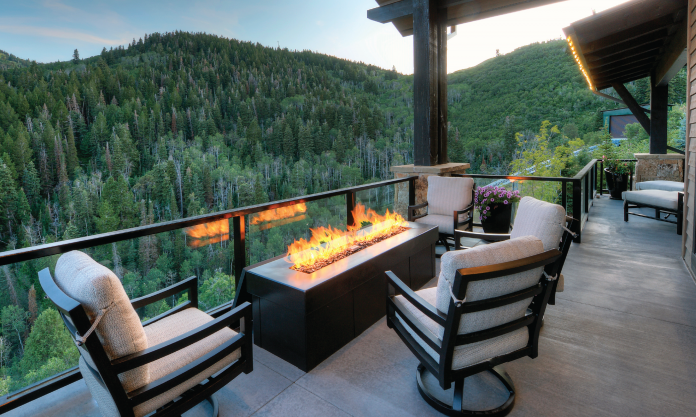FROM BLUEPRINTS TO FINISHES
GREAT DESIGN BEGINS WITH VISION, BUILDS WITH PASSION & SUCCEEDS WITH TEAMWORK
When Grant and Donna Lippincott first bought their 2.27-acre lot on the mountainside of Deer Valley Resort, they had three key requirements for their future home: ample space for family and friends to comfortably gather, ski-in ski-out access from an on-site gondola, and awe-inspiring views of the resort and the Jordanelle from every room.
Given the complexity of the project, they selected a team of professionals whose expertise matched their vision. Rick Otto of Otto/Walker Architects, Craig Mogel of Germania Construction and Paula Berg of Paula Berg Design—a team of Park City locals who are proven masters of their craft and are no strangers to collaboration, having worked together for years.
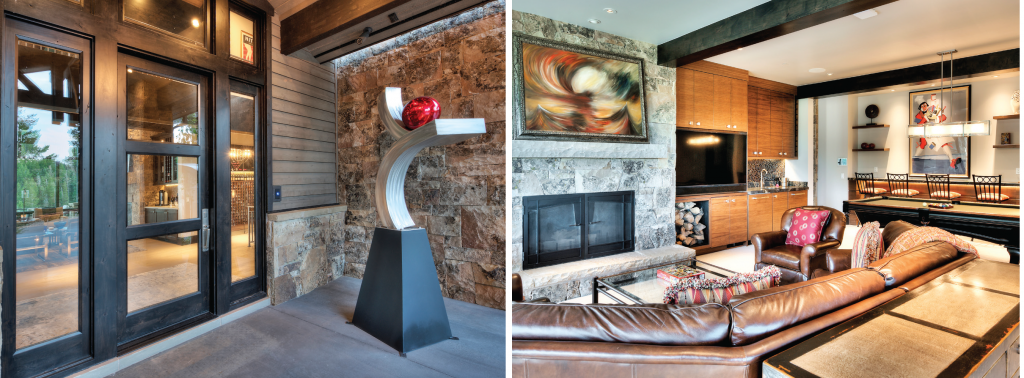
THE BLUEPRINT – WHERE THE MAGIC BEGINS
Situated on a ridgeline within the Deer Crest community, offering unblemished views of Bald Mountain to the south and the Jordanelle to the east, lead architect Rick Otto looked to nature to dictate his design. “As an office, our theory is we like contemporary design, but first and foremost, we want the house to feel like it still belongs in the mountains,” Otto explained. Using traditional materials and architectural details like exposed timber beams and gabled roofs with wide eaves, Otto sought to create a timeless structure that accentuated the landscape without overshadowing it. “What we were trying to achieve was a mountain transitional home—clean on the interior moving toward a contemporary set of finishes.”
With a commitment to preserving the natural topography and integrating the area aesthetic into his work, Otto’s focus was maximizing the views from every room. Using walls of glass and an open floor layout, he blended the interior and exterior spaces, blurring the lines between where the walls end and the mountains begin. Views this magical are meant to be shared and savored, which is why his design incorporated a combination of spaces that inspired both togetherness and reflection. Building on the Lippincott’s love for entertaining, he conceptualized two living rooms for multi-generational gatherings, an in-law suite and bunk quarters with enough beds for 12 guests. He intermixed intimate corners for quieter moments throughout, like daughter Abigail’s book nook, Grant’s in-home office and two wrap-around patios perfect for sunset watching from every level.
When designing a home, every room takes a great level of detail and consideration, but there are some rooms that evolve naturally during the design process like this home’s private theatre and golf simulation room. And then there are other spaces that take extra time and attention to get just right. For Otto that was the kitchen, dining and living rooms, the focal points of the home. Aft er enlarging the dining room to hold more guests, perfecting the pantry and breakfast nook, and detailing Grant’s wine cellar fi nalizing the fi rst level gave Otto a sense of accomplishment.
“Happiness for me is being able to walk into each room and enjoy a beautiful view. It makes me feel like my work was completed.”
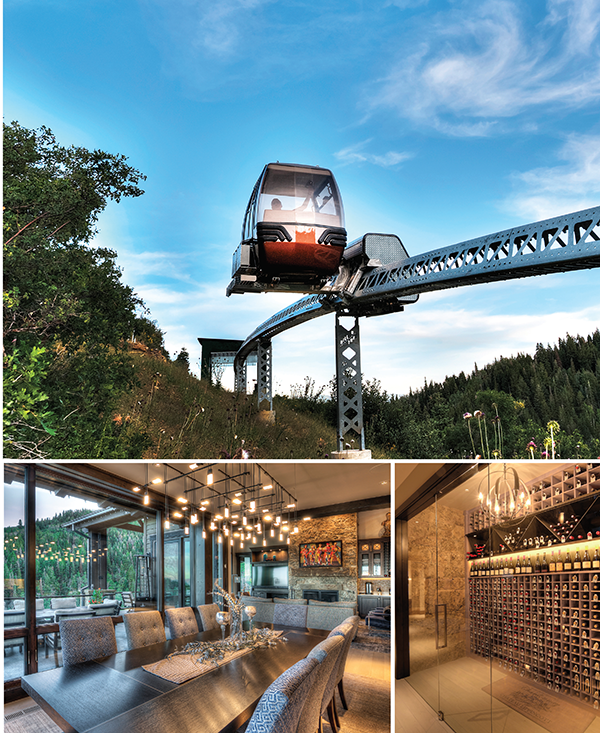 FROM THE GROUND UP
FROM THE GROUND UP
With over 20 years of building highly technical and impressively craft ed luxury homes at high altitudes, Craig Mogel is a proven master of this market. Balancing the Deer Crest specific building codes with the necessary infrastructure and intricate architectural details, his team was able to take Rick Otto’s design and the Lippincott’s vision and create a seamless ski-in ski-out home that embodied luxury mountain living.
“When you are this close to Deer Valley you have to take advantage of it,” said Mogel referring to the home’s private door-to-slope Hilltrack, the first ever used in a residential home. With a push of a button, a heated gondola swifts skiers up to Navigator Run from an oversized ski room—complete with personal boot dryers and hand warmers for 14. Taking advantage of its mountaintop position, Mogel expanded on Otto’s large window design by capturing the solar energy that came through the glass to implement radiant cooling in conjunction with the HVAC. A sustainable energy alternative that is hard to achieve in homes at this altitude and caliber.
Another big consideration Mogel and his crew had for this project was how to utilize technology to enhance livability without detracting from the home’s connection to nature. Strategically, they incorporated all systems into the “brain” of the house that could be accessed by an iPad. Using C4 technology, all audio, video, HVAC, lighting, security and door controls could be adjusted remotely either individually or by pre-set modes based on mood or time of day. They also creatively wove technology throughout the home in discreet and practical ways, like lining the bathroom floors with nightlights, placing USB ports and reading lamps by beds and constructing entertainment systems that lived behind the walls of paintings in bedrooms.
“Before we dig a house we stake out the footprint and make sure we understand what materials are needed to make this home withstand the elements while still achieving the look desired,” said Mogel. His team used a variety of materials like ultra insulated roofs to vent out the ice and traditional materials like natural stone staircases and rustic wood beams. Once the envelope was created, with the help of interior designer Paula Berg, they were able to utilize contemporary and one-of-a-kind finishes like live finished hardwood floors. “You walk in at noon and it has a completely different feeling than it does in the evening,” commented Mogel. “Custom details like this really make the house come alive and feel timeless.”
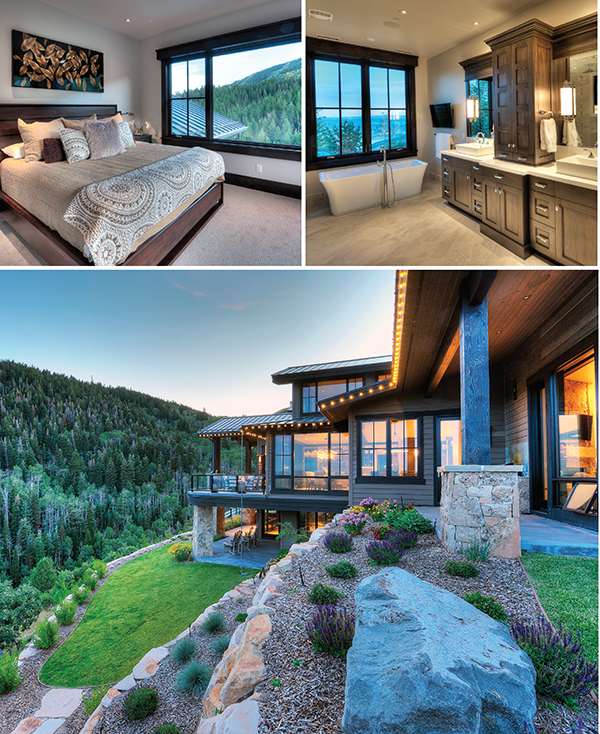 TURNING A HOUSE INTO A HOME
TURNING A HOUSE INTO A HOME
Once the blueprints were complete and the building permits were pulled, Paula Berg, Neil Peterson and Mike Lofgren of Paula Berg Design set to work on imagining the details. From pulling hues and textures from the landscape to selecting the stone and layout of the fireplaces, they spent a lot of time working and reworking every facet of the home to ensure each room flowed well into the next. Interior design, especially in a home of this consideration, takes equal parts experience, industry knowledge and communication. “I’ve been doing this for 40 years and over that time I’ve learned to become in tune with what the client wants and what their lifestyle is,” explained Paula Berg. “It’s what differentiates a designed house from a designed home.”
The Lippincotts wanted the interior of their home to blend traditional and contemporary styles in a way that accentuated the views and encompassed their family style. Each room required different considerations, and for Berg it was important that she selected the right materials, furnishings and colors to embody and withstand its intent. “A lot of what good design is based on is emotion and connection,” Berg stated. This is why Mike Lofgren hand drew focal details—a process Berg believes is essential for the client to fully understand the final product. “I want them to visualize what their bathrooms and fi replaces will look and feel like.”
Berg incorporated contemporary touches throughout the home by juxtaposing unique lighting fixtures, detailed tile patterns and textured materials with the home’s clean lines and natural tones. Her goal was to find creative ways to use design to complement the views without adding so much complexity that her design detracted from them. To achieve this she took standard materials like tile and selected distinct patterns and layouts to add a subtle but eye-catching flair to the bathrooms and kitchen. In the game room, she brought in metallic tiles in the backsplash to match the playful aesthetic of the space. She also utilized textured fabrics and furniture, especially in the bedrooms and living rooms, and more tactile materials like fossil stone on the fi replace to add diversity to each room.
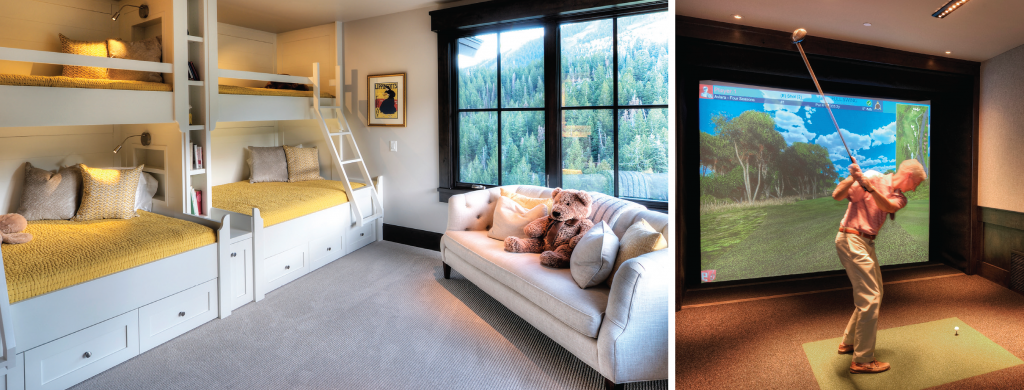
Berg found ways to integrate special pieces from the family’s history and travels throughout the home, specifically their eclectic collection of art. She selected neutral tones for the walls and fl oors and used a piece of art as her pop of color. In the living and dining room she used stronger blue tones and more vibrant colors that she pulled from a large painting resting above the fireplace. Little mementos from their travels were also highlighted in her design, like the breakfast nook which featured a tabletop brought back from a family trip to Morocco. “It takes a lot of consideration and a lot of hard work to meet the vision of what a client wants and doesn’t want for their family home. The Lippincott’s appreciation for all the efforts my team, Otto/Walker Architects and Germania Construction put into this, is what makes this job so worthwhile.”
It’s not every day a designer, builder and an architect can work so effortlessly together to achieve a project of this complexity. There is a synergy in their relationship that stems from the number of projects they have completed together and a deep respect for each other’s craft. “When you put this team together, you get one of the best teams in Park City,” said Craig Mogel. “Not only because we all know what we are doing and work well together, but because each of us knows how to put the client first and
really understand their vision.”
by Amber Qalagari

